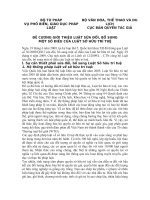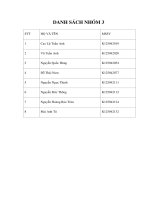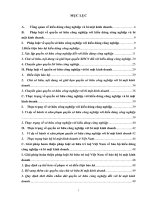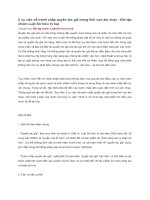Luật sở hữu trí tuệ Bai 1 2014 phan 1 tviet sv
Bạn đang xem bản rút gọn của tài liệu. Xem và tải ngay bản đầy đủ của tài liệu tại đây (992.23 KB, 21 trang )
CHƢƠNG 1 / CHAPTER 1
TỔNG QUAN VỀ TÀI SẢN TRÍ TUỆ
VÀ QUYỀN SỞ HỮU TRÍ TUỆ
OVERVIEW OF INTELLECTUAL ASSET & INTELLECTUAL PROPERTY RIGHTS
NỘI DUNG CHƢƠNG 1
CHAPTER OUTLINE
Lê Hà - FTU
Module 1: Tài sản trí tuệ /Intellectual asset
• Khái niệm (Concept)
• Đặc điểm (Characteristics
Module 2: Quyền SHTT / Intellectual Property
Rights
• Khái niệm (Concept)
• Đặc trƣng (Characteristics)
• Sự cần thiết của bảo hộ quyền sở hữu trí tuệ (Rational of
protection of IPR)
• Pháp luật SHTT (IP law system)
2
TÀI LIỆU THAM KHẢO CHƢƠNG 1
READING MATERIALS
Tài liệu bắt buộc/Compulsory reading materials
Chapter 1, Part I: The concept of IP, WIPO Intellectual
Property Handbook: Policy, Law and Use.
Đào Minh Đức, Tài sản vô hình và tài sản trí tuệ trong
kinh doanh
M Blakeney, Basic concept of IP
Tài liệu nâng cao /Suggested reading materials
DR. PETER DRAHOS, THE UNIVERSALITY OF
INTELLECTUAL PROPERTY RIGHTS: ORIGINS AND
DEVELOPMENT
Giovanni Dosi, Joseph Stiglitz, The Role of Intellectual
Property Rights in the Development Process, with
Some Lessons from Developed Countries: An
Introduction
Lê Hà - FTU
3
TÀI SẢN VÔ HÌNH
INTANGIBLE ASSETS
Kinh nghiệm (Experience)
Bí quyết (Know How)
Kỹ năng (Skills)
Creativity
Vốn con
ngƣời
Human capital
Tài sản trí tuệ Intellectual asset
-----------------------
Kế hoạch kinh doanh (Business Plan)
Lê Hà - FTU
Trí tuệ Intellect
Tri thức Knowledge
Chƣơng trình (Programs)
Processes (Quy trình)
Invention (Phát minh)
Bản vẽ (Drawings)
Data (Dữ liệu)…
Sáng chế (Patent)
Nhãn hiệu (Trademark)
Quyền tác giả (Copyright )
Chỉ dẫn địa lý (Geo. Indication)
Sở hữu trí tuệ
Intellectual Property
4
TRÍ TUỆ / INTELLECT
Lê Hà - FTU
Trí tuệ: là khả năng của con ngƣời nhằm thu thập, xử
lý, lƣu trữ và khái quát hóa thông tin (biến thông
tin thành tri thức - knowledge) nhằm phục vụ cho
một mục đích cụ thể.
Intellect: Is an human ability to collect, process, store and
generalizing information (transfer information into knowledge) for a
particular purpose.
5
TÀI SẢN / ASSET
Tài sản hữu hình
Vốn con ngƣời (Human
capital)
Sáng kiến (idea), business
strategy (chiến lƣợc kinh
doanh), business plan (kế
hoạch kinh doanh), brand
(thƣơng hiệu), design (kiểu
dáng), invention (phát minh)
Tài sản trí tuệ (Intellectual
asset)
Lê Hà - FTU
Tài sản vô hình
Kinh nghiệm, kỹ năng,
sáng tạo, bí quyết
6
INTELLECTUAL ASSET
KNOWLEDGE CAPITAL OR INTELLECTUAL CAPITAL ?
Không tồn tại dƣới dạng hữu hình /lack physical substance
Có khả năng mang lại lợi ích kinh tế trong tƣơng lai (they are
viewed as sources of probable future economic profits);
Đƣợc thƣơng mại hóa bởi doanh nghiệp (to some extent, they
can be, retained and traded by a firm)
Lê Hà - FTU
IPR
Intellectual asset
Knowledge capital
7
Human capital
EXERCISE
Summerize “Intellectual Asset and Value creations”,
OECD
Assignment: Many companies said that “our people
are our greatest asset”. Your opinion ?
Đọc thêm: Đào Minh Đức, Tài sản vô hình và tài
sản trí tuệ trong kinh doanh
Lê Hà - FTU
8
QUYỀN SỞ HỮU TRÍ TUỆ
INTELLECTUAL PROPERTY RIGHTS
Lê Hà - FTU
Intellectual property (IP) refers to creations of the mind:
inventions, literary and artistic works, and symbols,
names, images, and designs used in commerce
WIPO – What is IP ? ( />
Intellectual property, very broadly, means the legal rights
which result from intellectual activity in the industrial,
scientific, literary and artistic fields.
WIPO Intellectual Property Handbook: Policy, Law and Use
( />
9
QUYỀN SỞ HỮU TRÍ TUỆ
INTELLECTUAL PROPERTY RIGHTS
Lê Hà - FTU
"Intellectual Property rights" means rights of
organizations or individuals in intellectual property
assets including copyright and rights neighboring on
copyright, industrial property rights and rights in plant
varieties .
Vietnam IPL, art 4.1
10
VẤN ĐỀ: CÓ GÌ SÁNG TẠO ?
What is the creativity or inventiveness ?
Lê Hà - FTU
11
Danh tiếng ?
Có gì sáng tạo trong tên gọi “Evian”?
Có gì sáng tạo trong tên gọi “Phú Quốc” vẫn tồn tại hàng trăm
Lê Hà - FTU
12
năm nay?
Có gì sáng tạo trong một danh sách khách hàng đƣợc bảo
mật của công ty ?
QUYỀN SỞ HỮU TRÍ TUỆ
INTELLECTUAL PROPERTY RIGHTS
Quyền
Sở hữu trí tuệ
Đầu tƣ
Lê Hà - FTU
Sáng tạo
Quyền sở hữu trí tuệ là các quyền đối với các
thành quả của hoạt động sáng tạo trí tuệ hoặc hoạt
động đầu tƣ trong các lĩnh vực công nghiệp, khoa
học, văn học và nghệ thuật
Intellectual property right means the legal rights which result from
intellectual activity and investment in the industrial, scientific, literary and
artistic fields
13
EXERCICE: CÁC ĐỐI TƢỢNG SHTT
14
U
N
D
I
S
P
C
C
A
C I R C U I T L A Y O U T D E S I G N S
O
P
E
P
S
Y
N
L
E
R
T
A
D
I
N
I
G
T
N
H
V
F
T
A
O
R
T R A D E M A R K
D
I
M
I N T E L L E C T U A L P R O P E R T Y
S
T
T
I
Y
I
G
O
N
N
EXERCICE: CÁC ĐỐI TƢỢNG SHTT
This represents the property of your mind of intellect (across, 20 letters)
2.
These rights automatically protect original layout designs for intergrated circuits,
and computer chip. (across, 18 letters)
3.
Information and materials of commercial or personnal value and kept secret
from the general public (down, 22 letters)
4.
Rights are used to protect new variety of plan by giving. These are exclusive
commercial rights to market a new variety or its reproductive material. (down,
12 letters)
5.
This protect the way manufactured products look (down, 6 letters)
6.
This is a right granted for any device, substance, method or process, which is
new, inventive and useful. (down, 6 letters)
7.
This protect the original expression of ideas, not the ideas themselves. (down, 9
letters)
8.
This can be a letter, number, words, phrases, sound, smell, shape, logo,
picture, aspect of packaging or any combination of these things (across, 9
letters)
15
1.
EXERCICE: CÁC ĐỐI TƢỢNG SHTT
16
1) A company wishes to ensure that no-one else can use their
logo
2) A singer wishes to assign the rights to reproduce a video
she made of her concert.
3) A new way to process milk so that there is no fat in any
cheese made from it.
4) A company has decided to invest in packaging, which is
distinctive, and they wish to ensure that they have sole use.
5) A company decides to use a logo that has the same
shape as its competitor but with a different colour.
READING TEXTS
M Blakeney, Basic concept of IP
Chapter 1, Part I: The concept of IP, WIPO
Intellectual Property
Lê Hà - FTU
17
SHTT TÁC ĐỘNG TỚI CUỘC SỐNG VÀ KINH
DOANH NTN ?
Lê Hà - FTU
Impact 5
4
3
2
1
1
2
3
4
5
Uncertainty
18
ĐẶC TRƢNG CỦA QUYỀN SHTT
CHARACTERISTICS OF IPR
Tính lãnh thổ
Territoriality
Tính độc
quyền
Exclusivity
Lê Hà - FTU
Tính đồng
thời
Ubiqui ty
Tác phẩm
Tài sản
Ấn phẩm
19
Minh hoạ những đặc trưng trên bằng các casestudy về QTG và QLQ
TÍNH ĐỒNG THỜI
QSHTT tồn tại độc lập với hàng hóa/dịch vụ mà nó mang (IPR
exist independently of the specific material good in which they
are corporated)
Mọi sản phẩm và dịch vụ đƣợc bảo hộ đều chứa QSHTT (Every
copy of protected product contains IPR)
QSHTT làm cho TSVH trở nên hữu hình hơn (IP protection
makes intangibles assets “a bit more tangible” by turning them
into exclusive assets)
Lê Hà - FTU
20
TÍNH LÃNH THỔ (THE TERRITORIALITY)
-
-
21
-
Không có QSHTT mang tính toàn cầu / There is
no international IP system.
Nguyên tắc: Luật mỗi quốc gia chỉ áp dụng và
có hiệu lực ở quốc gia đó / the laws of one
nation state apply only within that nation state
Ngoại lệ: thỏa thuận, điều ƣớc khu vực và quốc
tế (regional or international treaties)
TÍNH ĐỘC QUYỀN (EXCLUSIVE RIGHTS)
Exclusive = prerogative = độc quyền tạm thời
(temporary monopoly)
Đƣợc quy định bởi pháp luật chứ không phải là
một quyền tự nhiên (Established by law)
Giới hạn bởi thời gian, lãnh thổ và các ngoại lệ
(Limited by time, by territory, by exceptions and
limitations)
Hết thời hạn bảo hộ, thuộc về công chúng (After
that, IP protected belongs to public)
22
VAI TRÒ CỦA QUYỀN SHTT
Lê Hà - FTU
Khách hàng – Ngƣời dùng /
Customers-User
Công chúng / Public
Ngƣời sáng tạo / Creators
Ngƣời SX /Producers/ Firm
Nền kinh tế/ Xã hội
The economy/Society
Dabate on the role of IPR
23
VAI TRÒ CỦA IP TRONG CHUỖI GIÁ TRỊ
Lê Hà - FTU
24
WELFARE EFFECTS FROM STRONGER IPR
ENFORCEMENT
Market
characteristic
Exemple of products
Welfare effects
Trademark
Consumers
are misled
Pharmaceuticals chemicals,
pesticides, vehicle replacement parts,
foods and drink products, tobacco,
electrical components, toys
Consumer: positive (especially where negative
externalities are present)
Producer: positive
Economy: positive
Consumers
are not misled
Fashion apparel, footwear, handbags,
personal
Consumer of counterfeit goods: negative
Consumer of genuine goods: positive
Producer: positive
Economy: ambiguous
No demand
linkage
present
Designs (cars, tools, toys), industrial
technology, literary works
Consumer of infringing goods: negative
Consumer of original goods: ambiguous
Producer: positive
Economy: assuming standards of protection are
socially optimal, ambiguous otherwise
Demand
linkage
present
Certain types of computer software,
patented technology that involves in
to an industrial standard, audiovisual
recording , DVD, CD and video play
games
Consumer of infringing goods: negative
Consumer of original goods: negative
Producer: ambiguous
Economy: ambiguous
Copyright,
patent and
related rights
Lê Hà - FTU
IPR
25
Carsten Fink, WIPO/ACE/5/6)
EVOLUTION OF IPR
REFERENCE:
Dr. Peter Drahos, The Universality of Intellectual
Property Rights: Origins and Development
26
SỰ CẦN THIẾT BẢO HỘ QSHTT / RATIONALE OF IPR
Tri thức và thông tin mang hai thuộc tính của hàng hóa công
Tính không thể loại trừ
Tính không cạnh tranh
27
Global
public good
Hàng hóa
công
• Cần có cơ chế để sáng tạo, đổi mới trở thành hàng hóa tư trong một khoảng thời gian
nhất định để kích thích các nhà sáng tạo
• Sở hữu trí tuệ là cơ chế trao độc quyền cho chủ sở hữu của các sáng tạo, đổi mới trong
một khoảng thời gian
• Có những tiêu chuẩn nhất định để tri thức, đổi mới nhận được quyền sở hữu trí tuệ
BẢO
HỘ QUYỀN SỞ HỮU TRÍ TUỆ
PROTECTION OF INTELLECTUAL PROPERTY RIGHTS
• Ban hành
pháp luật
Nhà
nƣớc
Chủ
thể
Cơ
quan
thực thi
Cộng
đồng
Tạo ra
Xác lập quyền
Khai thác
Bảo vệ
Lê Hà - FTU
• Bảo vệ
quyền và lợi
ích của chủ
thể quyền
•
•
•
•
• Tôn trọng
quyền SHTT
28
HỆ THỐNG BẢO HỘ QUYỀN SỞ HỮU TRÍ TUỆ
SYSTEM OF INTELLECTUAL PROPERTY RIGHTS
Facilate IP
CREAION
(eg: patent
databases as
sources of
innovative ideas)
Support IP
APPROPRIATION
(eg: higher profits
with innovative
products, establish
goodwill and
reputation in the
market
Chủ
thể
Provide IP
PROTECTION
(eg: protection from
illegal reproduction
and loss of profits)
Các đối
tƣợng
SHTT
Lê Hà - FTU
Nhà
nƣớc
Cơ
quan
thực
thi
Prevent IP
ABUSES
(eg: unfaire
competition)
Cộng
đồng
HỆ THỐNG PHÁP LUẬT
29
SHTT
IP SYSTEM LEGISLATION
-
-
-
-
Lê Hà - FTU
-
Hiệp ƣớc quốc tế của WIPO: 26
Hiệp ƣớc quốc tế của WTO: TRIPs
Các hiệp định song phƣơng và khu vực về
SHTT
Luật quốc gia:
Civil law
Common law
30
WIPO CONVENTIONS
Global Protection
System
Classification
Berne Convention
Budapest Treaty
Locarno Agreement
Brussels Convention
Hague Agreement
Nice Agreement
Nairobi Treaty
Lisbon Agreement
Strasbourg
Madrid Agreement
Madrid Agreement
Paris Convention
Madrid Protocol
Patent Law Treaty
PCT
Lê Hà - FTU
IP Protection
Phonograms Convention
Rome Convention
Singapore Treaty on the
Law of Trademarks
Trademark Law Treaty
TRIPs - WTO
31
Washington Treaty
WCT & WPPT
TRIPS (2007)
CU Berne (2004)
CU Rome (2007)
CU Brussel (2006)
WPPT (Biểu diễn và
bản ghi âm)
Madrid Agr
Related Rights
Madrid Protocol
Trade-mark
Patent Coop Treaty
Inventions/ GPHI
Hague Agr
Industrial
Designs
Budapest
Geographical
Indications
Lisbon Agr
Lê Hà - FTU
CU Geneve (2005)
Copyright
Trade Secrets
Locarno Agreement
CU Paris (1949)
Trade name
CU Washington
Layout Designs
UPOV
Plant Varieties
Nice Agreement
32
Strasbourg
MỐI QUAN HỆ TRIPS VÀ CÁC ĐUQT WIPO
Incorporation of Paris and Berne conventions,
Washington Agreement, Art 2,9 and 35 Trips
Reference to Rome Conv, Art 2.2, 3
Lê Hà - FTU
33
NGUYÊN TẮC BẢO HỘ
PRINCIPLE OF IPR PROTECTION
Bảo hộ chọn lọc
Nguyên tắc cân bằng lợi
ích của chủ sở hữu và
của cộng đồng
© Lê Hà - FTU
Bảo hộ có mục đích
thúc đẩy hoạt động sáng
tạo
Độc quyền
Exclusive’s right
Bảo hộ có điều kiện
không đi ngƣợc lại lợi ích
xã hội
(Bulgaria- Senegal)
Bảo hộ có thời hạn
34
Homework: Minh hoạ mỗi ý 1 casestudy về Giống cây trồng
CASES TUDY: TRIPS
Article 7:
to the promotion of technological innovation and to the
transfer and dissemination of technology,
to the mutual advantage of producers and users of
technological knowledge and in a manner conducive to
social and economic welfare, and to a balance of rights and
obligations
Lê Hà - FTU
The protection and enforcement of intellectual
property rights should contribute
(Điều 7) Việc bảo hộ và thực thi các quyền SHTT phải :
góp phần thúc đẩy việc cải tiến, chuyển giao và phổ biến công nghệ,
góp phần đem lại lợi ích chung cho ngƣời tạo ra và ngƣời sử dụng kiến thức công
nghệ, đem lại lợi ích xã hội và lợi ích kinh tế, và tạo sự cân bằng giữa quyền và nghĩa
vụ.
35
CASESTUDY: TRIPS
Article 8:
Members may adopt measures necessary to protect public health
and nutrition, and to promote the public interest in sectors of vital
importance to their socio-economic and technological development,
provided that such measures are consistent with the provisions of
this Agreement.
[…] các thành viên có thể thực hiện các biện pháp cần thiết để bảo đảm vấn đề y tế và
dinh dƣỡng cho nhân dân, và thúc đẩy lợi ích công cộng trong những lĩnh vực có tầm
quan trọng sống còn đối với sự phát triển kinh tế - xã hội và công nghệ của mình, với
điều kiện là các biện pháp đó không đƣợc trái với các quy định của Hiệp định.
[...] to prevent the abuse of intellectual property rights by right holders
or the resort to practices which unreasonably restrain trade or
adversely affect the international transfer of technology.
Lê Hà - FTU
[…] ngăn chặn các hành vi gây cản trở hoạt động thƣơng mại một cách bất hợp lý hoặc
gây ảnh hƣởng xấu đến việc chuyển giao công nghệ quốc tế.
36
CASESTUDY: TRIPS
Article 27.2:
Members may exclude from patentability inventions, the
prevention within their territory of the commercial exploitation
of which is necessary to protect order public or morality,
including to protect human, animal or plant life or health or to
avoid serious prejudice to the environment, []
Cỏc Thnh viờn cú th loi tr khụng cp patent cho nhng sỏng ch cn phi b cm
khai thỏc nhm mc ớch thng mi trong lónh th ca mỡnh bo v trt t cụng
cng hoc o c xó hi, k c bo v cuc sng v sc kho ca con ngi v
ng vt hoc thc vt hoc trỏnh gõy nguy hi nghiờm trng cho mụi trng []
Lờ H - FTU
37
PHP LUT QUC GIA V SHTT
NATIONAL LAW ON IPR
B LUT DN S 2005
Lờ H - FTU
HIN PHP 1992
Công dân có quyền nghiên cứu khoa học, kỹ thuật, phát minh, sáng chế, sáng kiến cải
tiến kỹ thuật, hợp lý hoá sản xuất, sáng tác, phê bình văn học, nghệ thuật và tham gia
các hoạt động văn hoá khác. Nhà nớc bảo hộ quyền tác giả, quyền sở hữu công nghiệp.
(A60)
PHN 6: QUYN SHTT V CHUYN GIAO CễNG NGH (Chng 34, 35 v 36)
PHN 7: QUAN H DN S Cể YU T NC NGOI
LUT S HU TR TU 2005
6 PHN, 18 CHNG, 222 IU
Ngh nh 100 v QTG
Ngh nh 103/2006 v quyn SHCN v N 122/2010 sa i
Ngh nh 103/2006 v ging cõy trng
Ngh nh 105/2006 v N 119 sa i N 105 v bo v quyn SHTT
Ngh nh 106 v x pht hnh chớnh quyn SHCN
Thụng t 01 /2007 hng dn thi hnh N 103/2006 b sung bi Thụng
t13/2010 ngy 30/7/2010 v Thụng t s 18/2011/TT-BKHCN ngy 22/7/2011
38
NGUYấN TC P DNG
APPLICABLE LAW
2.
3.
Lờ H - FTU
Trong trng hp cú nhng vn dõn s liờn quan n s
hu trớ tu khụng c quy nh trong Lut ny thỡ ỏp dng
quy nh ca B lut Dõn s.
Trong trng hp cú s khỏc nhau gia quy nh v s hu
trớ tu ca Lut ny vi quy nh ca lut khỏc thỡ ỏp dng quy
nh ca Lut ny.
Trong trng hp iu c quc t m Cng ho xó hi ch
ngha Vit Nam l thnh viờn cú quy nh khỏc vi quy nh
ca Lut ny thỡ ỏp dng quy nh ca iu c quc t ú.
iu 5, Lut SHTT)
1.
39
THE NATIONAL LAW ON IPR
2005 CIVIL CODE OF VIETNAM
Lờ H - FTU
1992 Constitution
Công dân có quyền nghiên cứu khoa học, kỹ thuật, phát minh, sáng chế, sáng kiến cải
tiến kỹ thuật, hợp lý hoá sản xuất, sáng tác, phê bình văn học, nghệ thuật và tham gia
các hoạt động văn hoá khác. Nhà nớc bảo hộ quyền tác giả, quyền sở hữu công nghiệp.
(A60)
PART 6: QUYN SHTT V CHUYN GIAO CễNG NGH (Chng 34, 35 v 36)
PART 7: QUAN H DN S Cể YU T NC NGOI
LAW ON IP 2005
6 PARTS, 18 CHAPTERS, 222 ARTICLES
Ngh nh 100 v QTG
Ngh nh 103/2006 v quyn SHCN v N 122/2010 sa i
Ngh nh 103/2006 v ging cõy trng
Ngh nh 105/2006 v N 119 sa i N 105 v bo v quyn SHTT
Ngh nh 106 v x pht hnh chớnh quyn SHCN
Thụng t 01 /2007 hng dn thi hnh N 103/2006 b sung bi Thụng
t13/2010 ngy 30/7/2010 v Thụng t s 18/2011/TT-BKHCN ngy 22/7/2011
40
Thank you for the kind attention !
Lê Hà - FTU
Q&A
Email:
Tel: 0912211178
41









